Impact of Leadership on Health and Social Care Organizations Report
VerifiedAdded on 2019/12/28
|10
|2068
|158
Report
AI Summary
This report examines the impact of organizational structure and culture on health and social care service delivery, focusing on leadership's role. It compares and contrasts different organizational structures, analyzes organizational culture, and explores individual and group behavior theories within healthcare settings. The report explains how organizational structure and culture influence service delivery, discussing functional, divisional, and entrepreneurial structures. It further analyzes leadership concepts, its influence on organizational effectiveness, and specific leadership contributions. The analysis covers leadership skills, team leadership, and organizational leadership, emphasizing their impact on quality care, strategic narratives, and staff engagement. The report also references relevant theories and studies on leadership, organizational behavior, and diversity management in healthcare, providing a comprehensive overview of these critical aspects. This report is a valuable resource for students studying leadership and management in the health and social care sector, providing insights into the complex interplay of organizational dynamics and service delivery.
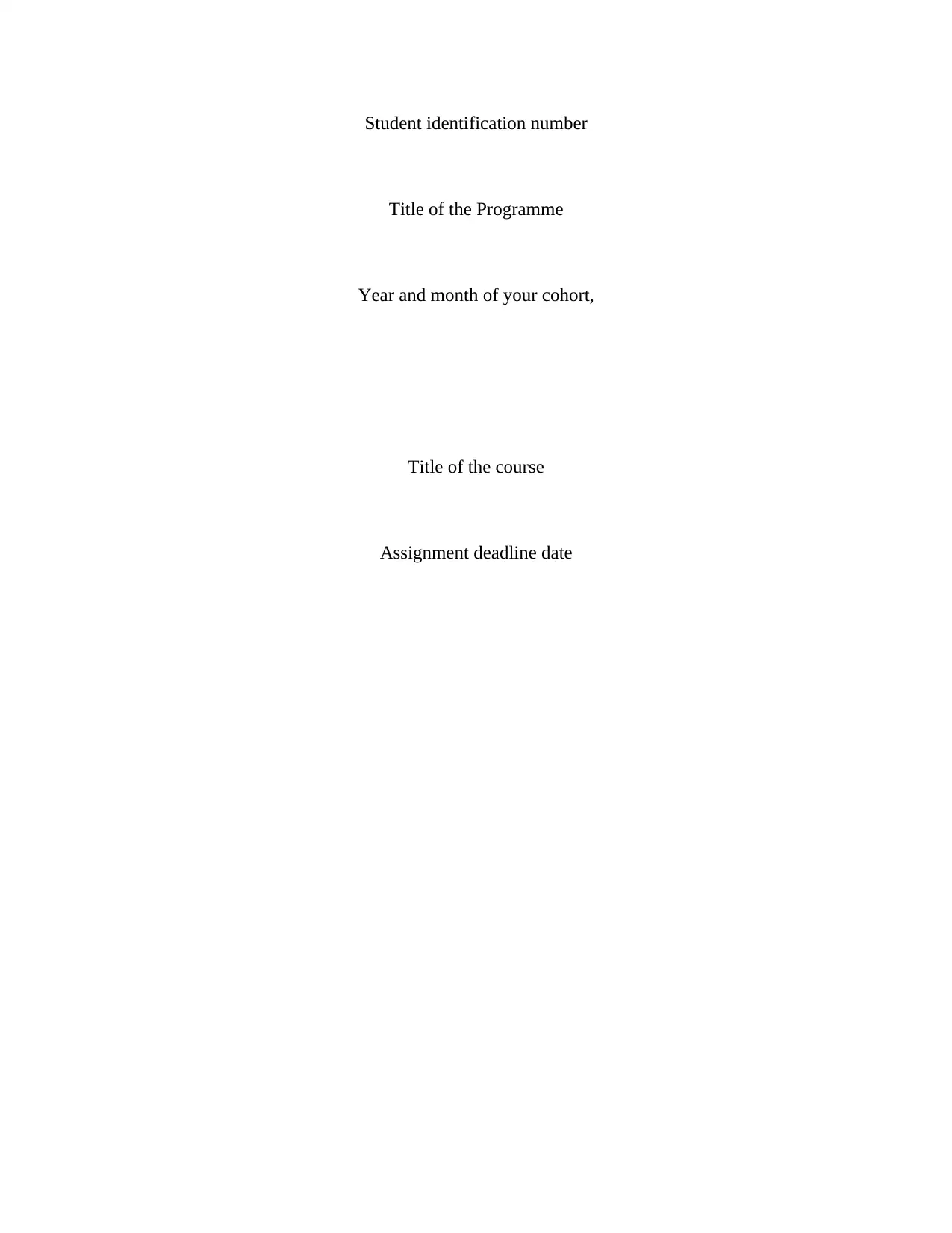
Student identification number
Title of the Programme
Year and month of your cohort,
Title of the course
Assignment deadline date
Title of the Programme
Year and month of your cohort,
Title of the course
Assignment deadline date
Paraphrase This Document
Need a fresh take? Get an instant paraphrase of this document with our AI Paraphraser
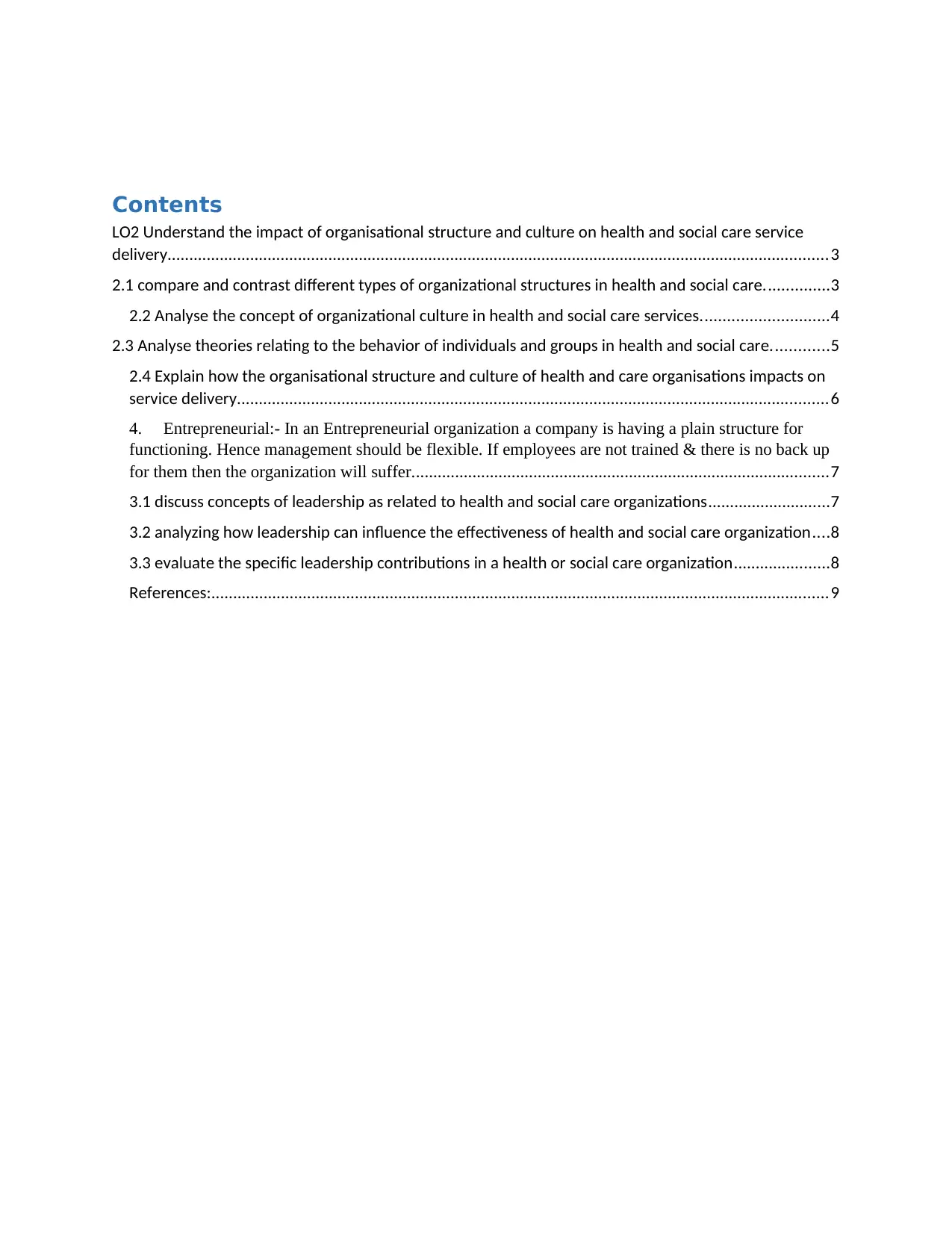
Contents
LO2 Understand the impact of organisational structure and culture on health and social care service
delivery........................................................................................................................................................3
2.1 compare and contrast different types of organizational structures in health and social care...............3
2.2 Analyse the concept of organizational culture in health and social care services.............................4
2.3 Analyse theories relating to the behavior of individuals and groups in health and social care.............5
2.4 Explain how the organisational structure and culture of health and care organisations impacts on
service delivery........................................................................................................................................6
4. Entrepreneurial:- In an Entrepreneurial organization a company is having a plain structure for
functioning. Hence management should be flexible. If employees are not trained & there is no back up
for them then the organization will suffer................................................................................................7
3.1 discuss concepts of leadership as related to health and social care organizations............................7
3.2 analyzing how leadership can influence the effectiveness of health and social care organization....8
3.3 evaluate the specific leadership contributions in a health or social care organization......................8
References:..............................................................................................................................................9
LO2 Understand the impact of organisational structure and culture on health and social care service
delivery........................................................................................................................................................3
2.1 compare and contrast different types of organizational structures in health and social care...............3
2.2 Analyse the concept of organizational culture in health and social care services.............................4
2.3 Analyse theories relating to the behavior of individuals and groups in health and social care.............5
2.4 Explain how the organisational structure and culture of health and care organisations impacts on
service delivery........................................................................................................................................6
4. Entrepreneurial:- In an Entrepreneurial organization a company is having a plain structure for
functioning. Hence management should be flexible. If employees are not trained & there is no back up
for them then the organization will suffer................................................................................................7
3.1 discuss concepts of leadership as related to health and social care organizations............................7
3.2 analyzing how leadership can influence the effectiveness of health and social care organization....8
3.3 evaluate the specific leadership contributions in a health or social care organization......................8
References:..............................................................................................................................................9

LO2 Understand the impact of organisational structure
and culture on health and social care service delivery
2.1 compare and contrast different types of organizational
structures in health and social care.
In today’s globalised and competitive environment, organizations are complex which try to make
the best use of people as well as of essential resource. For the development of organizational
structure factors like as below:
Environment: - A successful organization understand its needs the requirement of the
environment as they are selling their products in this environment. Organization has to
understand & recognize the factors such as their suppliers & competitors.
Technology:-A combination of knowledge & techniques create an Organizations product &
services.
Scale: - For more complicated structure of an organization one should have large number of
people on less likelihood for direct contacts.
1. Organizational Structure:- For critical organizational success eight cultural characteristics
have been identified they are as below:-
a. Doing things rather than discussing
b. Best efforts should be rewarded
c. For giving best focus should be planned.
d. Encouragement should be given for thinking.
2. Functional Structure:-Functional structure is allotted to trained teams & individuals in
order to get the task done. Knowledge is shared among the employees, customers and
and culture on health and social care service delivery
2.1 compare and contrast different types of organizational
structures in health and social care.
In today’s globalised and competitive environment, organizations are complex which try to make
the best use of people as well as of essential resource. For the development of organizational
structure factors like as below:
Environment: - A successful organization understand its needs the requirement of the
environment as they are selling their products in this environment. Organization has to
understand & recognize the factors such as their suppliers & competitors.
Technology:-A combination of knowledge & techniques create an Organizations product &
services.
Scale: - For more complicated structure of an organization one should have large number of
people on less likelihood for direct contacts.
1. Organizational Structure:- For critical organizational success eight cultural characteristics
have been identified they are as below:-
a. Doing things rather than discussing
b. Best efforts should be rewarded
c. For giving best focus should be planned.
d. Encouragement should be given for thinking.
2. Functional Structure:-Functional structure is allotted to trained teams & individuals in
order to get the task done. Knowledge is shared among the employees, customers and
⊘ This is a preview!⊘
Do you want full access?
Subscribe today to unlock all pages.

Trusted by 1+ million students worldwide
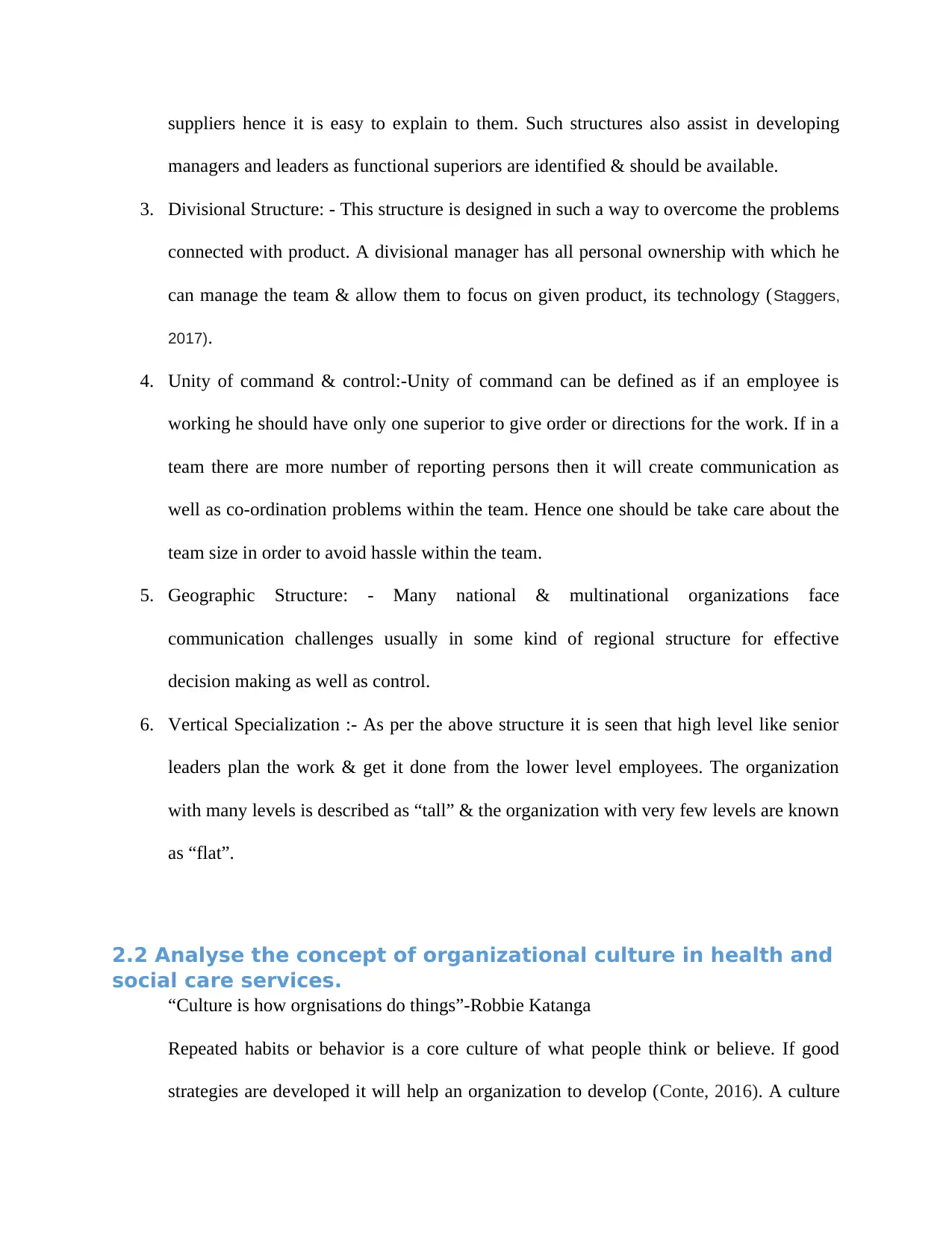
suppliers hence it is easy to explain to them. Such structures also assist in developing
managers and leaders as functional superiors are identified & should be available.
3. Divisional Structure: - This structure is designed in such a way to overcome the problems
connected with product. A divisional manager has all personal ownership with which he
can manage the team & allow them to focus on given product, its technology (Staggers,
2017).
4. Unity of command & control:-Unity of command can be defined as if an employee is
working he should have only one superior to give order or directions for the work. If in a
team there are more number of reporting persons then it will create communication as
well as co-ordination problems within the team. Hence one should be take care about the
team size in order to avoid hassle within the team.
5. Geographic Structure: - Many national & multinational organizations face
communication challenges usually in some kind of regional structure for effective
decision making as well as control.
6. Vertical Specialization :- As per the above structure it is seen that high level like senior
leaders plan the work & get it done from the lower level employees. The organization
with many levels is described as “tall” & the organization with very few levels are known
as “flat”.
2.2 Analyse the concept of organizational culture in health and
social care services.
“Culture is how orgnisations do things”-Robbie Katanga
Repeated habits or behavior is a core culture of what people think or believe. If good
strategies are developed it will help an organization to develop (Conte, 2016). A culture
managers and leaders as functional superiors are identified & should be available.
3. Divisional Structure: - This structure is designed in such a way to overcome the problems
connected with product. A divisional manager has all personal ownership with which he
can manage the team & allow them to focus on given product, its technology (Staggers,
2017).
4. Unity of command & control:-Unity of command can be defined as if an employee is
working he should have only one superior to give order or directions for the work. If in a
team there are more number of reporting persons then it will create communication as
well as co-ordination problems within the team. Hence one should be take care about the
team size in order to avoid hassle within the team.
5. Geographic Structure: - Many national & multinational organizations face
communication challenges usually in some kind of regional structure for effective
decision making as well as control.
6. Vertical Specialization :- As per the above structure it is seen that high level like senior
leaders plan the work & get it done from the lower level employees. The organization
with many levels is described as “tall” & the organization with very few levels are known
as “flat”.
2.2 Analyse the concept of organizational culture in health and
social care services.
“Culture is how orgnisations do things”-Robbie Katanga
Repeated habits or behavior is a core culture of what people think or believe. If good
strategies are developed it will help an organization to develop (Conte, 2016). A culture
Paraphrase This Document
Need a fresh take? Get an instant paraphrase of this document with our AI Paraphraser
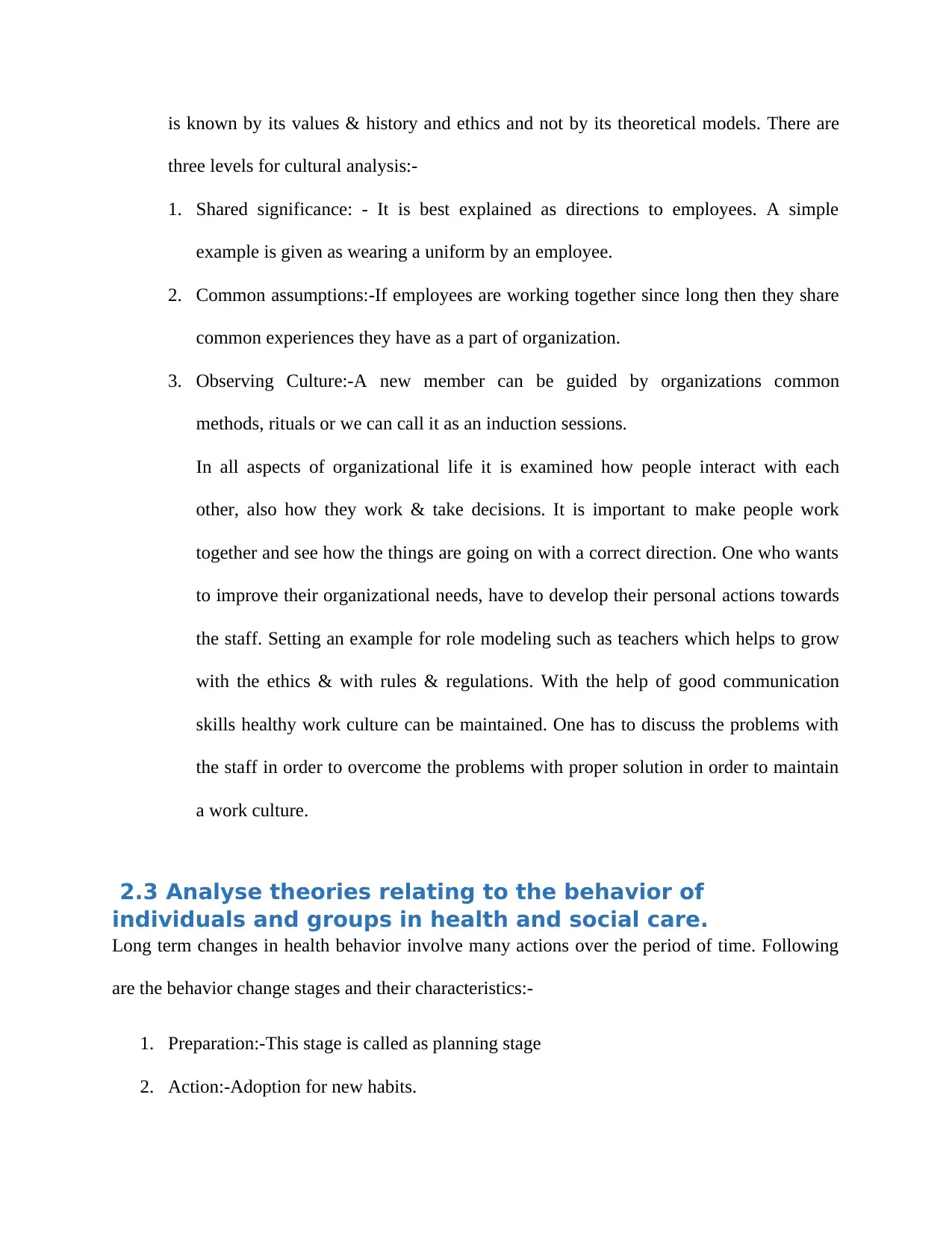
is known by its values & history and ethics and not by its theoretical models. There are
three levels for cultural analysis:-
1. Shared significance: - It is best explained as directions to employees. A simple
example is given as wearing a uniform by an employee.
2. Common assumptions:-If employees are working together since long then they share
common experiences they have as a part of organization.
3. Observing Culture:-A new member can be guided by organizations common
methods, rituals or we can call it as an induction sessions.
In all aspects of organizational life it is examined how people interact with each
other, also how they work & take decisions. It is important to make people work
together and see how the things are going on with a correct direction. One who wants
to improve their organizational needs, have to develop their personal actions towards
the staff. Setting an example for role modeling such as teachers which helps to grow
with the ethics & with rules & regulations. With the help of good communication
skills healthy work culture can be maintained. One has to discuss the problems with
the staff in order to overcome the problems with proper solution in order to maintain
a work culture.
2.3 Analyse theories relating to the behavior of
individuals and groups in health and social care.
Long term changes in health behavior involve many actions over the period of time. Following
are the behavior change stages and their characteristics:-
1. Preparation:-This stage is called as planning stage
2. Action:-Adoption for new habits.
three levels for cultural analysis:-
1. Shared significance: - It is best explained as directions to employees. A simple
example is given as wearing a uniform by an employee.
2. Common assumptions:-If employees are working together since long then they share
common experiences they have as a part of organization.
3. Observing Culture:-A new member can be guided by organizations common
methods, rituals or we can call it as an induction sessions.
In all aspects of organizational life it is examined how people interact with each
other, also how they work & take decisions. It is important to make people work
together and see how the things are going on with a correct direction. One who wants
to improve their organizational needs, have to develop their personal actions towards
the staff. Setting an example for role modeling such as teachers which helps to grow
with the ethics & with rules & regulations. With the help of good communication
skills healthy work culture can be maintained. One has to discuss the problems with
the staff in order to overcome the problems with proper solution in order to maintain
a work culture.
2.3 Analyse theories relating to the behavior of
individuals and groups in health and social care.
Long term changes in health behavior involve many actions over the period of time. Following
are the behavior change stages and their characteristics:-
1. Preparation:-This stage is called as planning stage
2. Action:-Adoption for new habits.
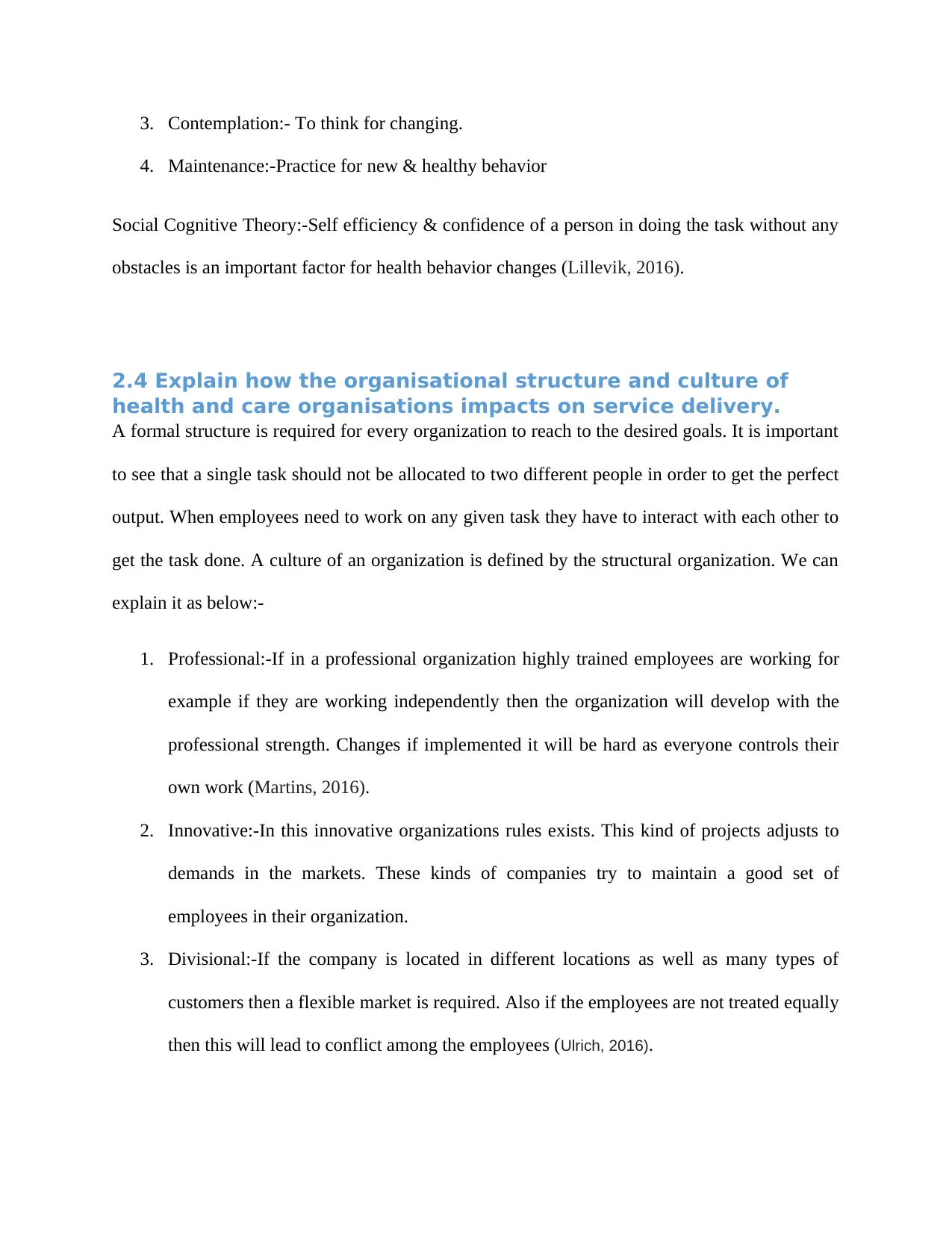
3. Contemplation:- To think for changing.
4. Maintenance:-Practice for new & healthy behavior
Social Cognitive Theory:-Self efficiency & confidence of a person in doing the task without any
obstacles is an important factor for health behavior changes (Lillevik, 2016).
2.4 Explain how the organisational structure and culture of
health and care organisations impacts on service delivery.
A formal structure is required for every organization to reach to the desired goals. It is important
to see that a single task should not be allocated to two different people in order to get the perfect
output. When employees need to work on any given task they have to interact with each other to
get the task done. A culture of an organization is defined by the structural organization. We can
explain it as below:-
1. Professional:-If in a professional organization highly trained employees are working for
example if they are working independently then the organization will develop with the
professional strength. Changes if implemented it will be hard as everyone controls their
own work (Martins, 2016).
2. Innovative:-In this innovative organizations rules exists. This kind of projects adjusts to
demands in the markets. These kinds of companies try to maintain a good set of
employees in their organization.
3. Divisional:-If the company is located in different locations as well as many types of
customers then a flexible market is required. Also if the employees are not treated equally
then this will lead to conflict among the employees (Ulrich, 2016).
4. Maintenance:-Practice for new & healthy behavior
Social Cognitive Theory:-Self efficiency & confidence of a person in doing the task without any
obstacles is an important factor for health behavior changes (Lillevik, 2016).
2.4 Explain how the organisational structure and culture of
health and care organisations impacts on service delivery.
A formal structure is required for every organization to reach to the desired goals. It is important
to see that a single task should not be allocated to two different people in order to get the perfect
output. When employees need to work on any given task they have to interact with each other to
get the task done. A culture of an organization is defined by the structural organization. We can
explain it as below:-
1. Professional:-If in a professional organization highly trained employees are working for
example if they are working independently then the organization will develop with the
professional strength. Changes if implemented it will be hard as everyone controls their
own work (Martins, 2016).
2. Innovative:-In this innovative organizations rules exists. This kind of projects adjusts to
demands in the markets. These kinds of companies try to maintain a good set of
employees in their organization.
3. Divisional:-If the company is located in different locations as well as many types of
customers then a flexible market is required. Also if the employees are not treated equally
then this will lead to conflict among the employees (Ulrich, 2016).
⊘ This is a preview!⊘
Do you want full access?
Subscribe today to unlock all pages.

Trusted by 1+ million students worldwide
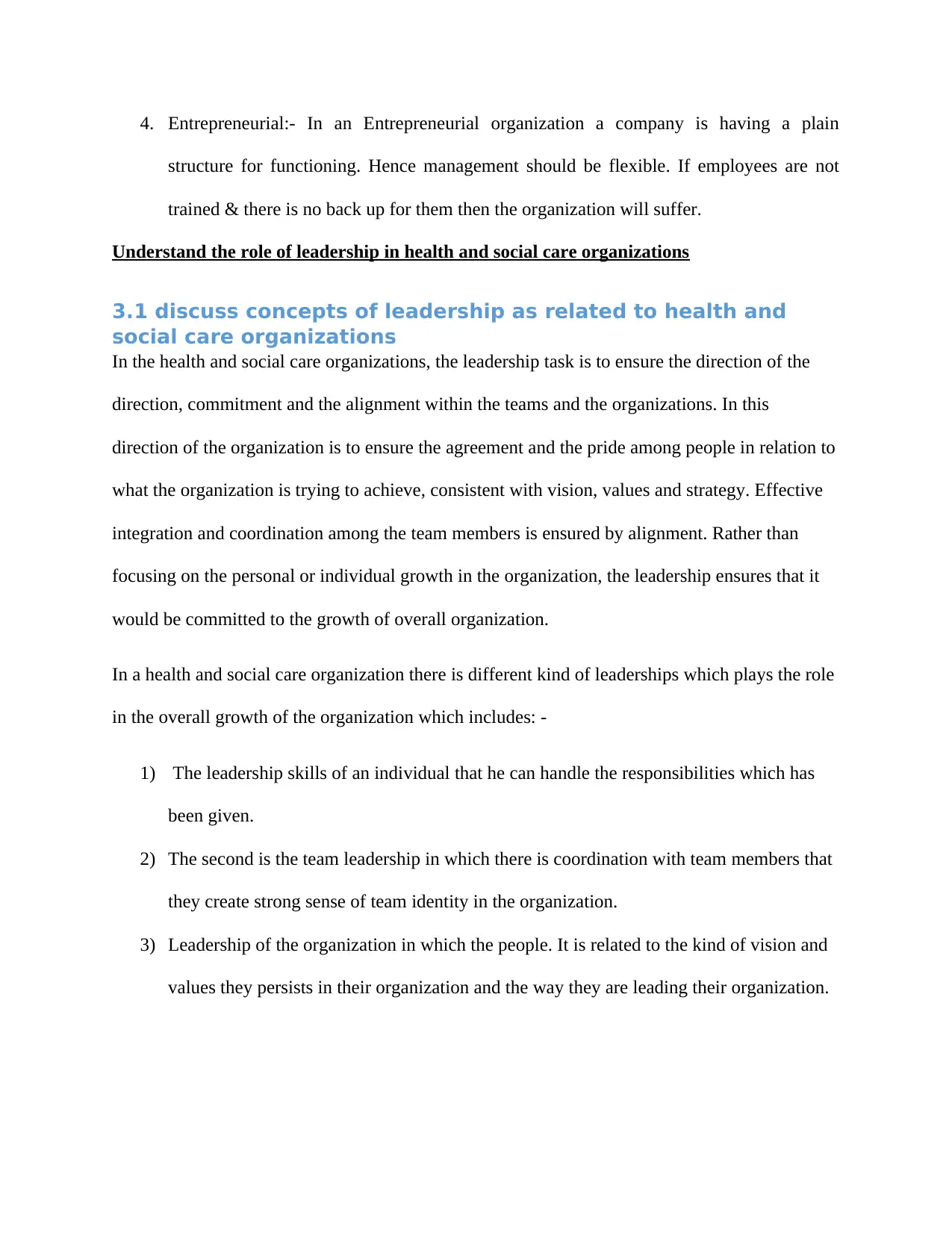
4. Entrepreneurial:- In an Entrepreneurial organization a company is having a plain
structure for functioning. Hence management should be flexible. If employees are not
trained & there is no back up for them then the organization will suffer.
Understand the role of leadership in health and social care organizations
3.1 discuss concepts of leadership as related to health and
social care organizations
In the health and social care organizations, the leadership task is to ensure the direction of the
direction, commitment and the alignment within the teams and the organizations. In this
direction of the organization is to ensure the agreement and the pride among people in relation to
what the organization is trying to achieve, consistent with vision, values and strategy. Effective
integration and coordination among the team members is ensured by alignment. Rather than
focusing on the personal or individual growth in the organization, the leadership ensures that it
would be committed to the growth of overall organization.
In a health and social care organization there is different kind of leaderships which plays the role
in the overall growth of the organization which includes: -
1) The leadership skills of an individual that he can handle the responsibilities which has
been given.
2) The second is the team leadership in which there is coordination with team members that
they create strong sense of team identity in the organization.
3) Leadership of the organization in which the people. It is related to the kind of vision and
values they persists in their organization and the way they are leading their organization.
structure for functioning. Hence management should be flexible. If employees are not
trained & there is no back up for them then the organization will suffer.
Understand the role of leadership in health and social care organizations
3.1 discuss concepts of leadership as related to health and
social care organizations
In the health and social care organizations, the leadership task is to ensure the direction of the
direction, commitment and the alignment within the teams and the organizations. In this
direction of the organization is to ensure the agreement and the pride among people in relation to
what the organization is trying to achieve, consistent with vision, values and strategy. Effective
integration and coordination among the team members is ensured by alignment. Rather than
focusing on the personal or individual growth in the organization, the leadership ensures that it
would be committed to the growth of overall organization.
In a health and social care organization there is different kind of leaderships which plays the role
in the overall growth of the organization which includes: -
1) The leadership skills of an individual that he can handle the responsibilities which has
been given.
2) The second is the team leadership in which there is coordination with team members that
they create strong sense of team identity in the organization.
3) Leadership of the organization in which the people. It is related to the kind of vision and
values they persists in their organization and the way they are leading their organization.
Paraphrase This Document
Need a fresh take? Get an instant paraphrase of this document with our AI Paraphraser

3.2 analyzing how leadership can influence the effectiveness of
health and social care organization
Leadership in the organization can contribute in building the effectiveness of work which is
conducted in any organization. They contribute in influencing the effectiveness through: -
1) Raising the cultures of high quality care in the health and social care organizations.
2) It contributes in inspiring the compelling visions and strategic narratives of the new
goals.
3) Clearing the objectives to the team leaders so that they can inspire their team to move
towards a joint goal of the organization.
4) It influences the management of the people and staff engagement.
5) It helps in promoting the learning, innovation and quality improvement of the task.
6) It promotes the power of team working.
3.3 evaluate the specific leadership contributions in a health or
social care organization
Coming towards the evaluation of the specific leadership contribution in a health or social care
organization there are certain key conclusions which has been done after the research into the
leadership over the last 80 years. This means that the effectiveness of leadership is being
analyzed from long time because every organization wants a strong hold in the market and they
can contribute in helping the patients to improve.
1) Leadership contributed in bringing in the effectiveness in the personality of an individual
and learning the leadership skills.
2) It contributed in building the high energy level and stress tolerance.
3) It increases the self confidence.
4) Internal locus of control
health and social care organization
Leadership in the organization can contribute in building the effectiveness of work which is
conducted in any organization. They contribute in influencing the effectiveness through: -
1) Raising the cultures of high quality care in the health and social care organizations.
2) It contributes in inspiring the compelling visions and strategic narratives of the new
goals.
3) Clearing the objectives to the team leaders so that they can inspire their team to move
towards a joint goal of the organization.
4) It influences the management of the people and staff engagement.
5) It helps in promoting the learning, innovation and quality improvement of the task.
6) It promotes the power of team working.
3.3 evaluate the specific leadership contributions in a health or
social care organization
Coming towards the evaluation of the specific leadership contribution in a health or social care
organization there are certain key conclusions which has been done after the research into the
leadership over the last 80 years. This means that the effectiveness of leadership is being
analyzed from long time because every organization wants a strong hold in the market and they
can contribute in helping the patients to improve.
1) Leadership contributed in bringing in the effectiveness in the personality of an individual
and learning the leadership skills.
2) It contributed in building the high energy level and stress tolerance.
3) It increases the self confidence.
4) Internal locus of control
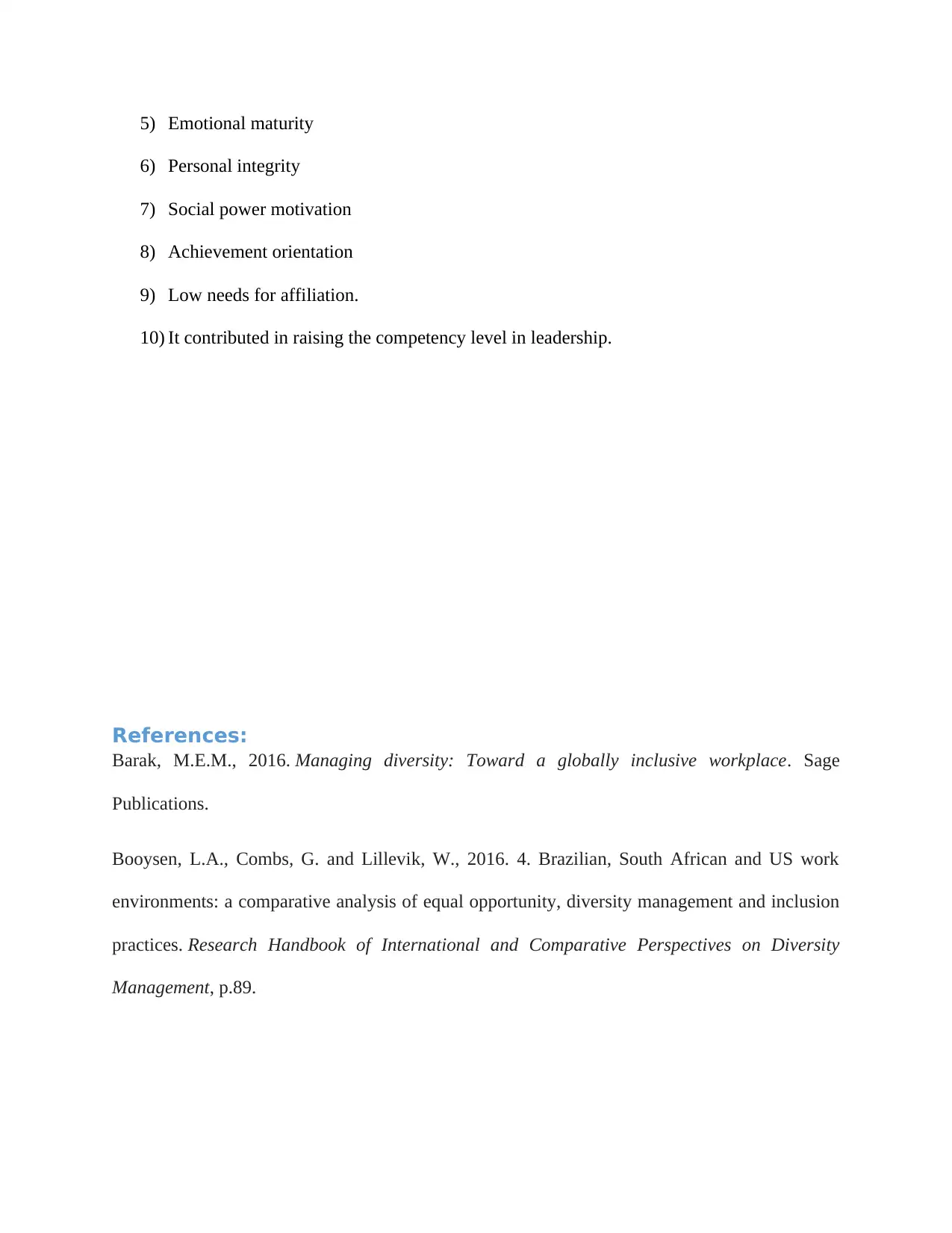
5) Emotional maturity
6) Personal integrity
7) Social power motivation
8) Achievement orientation
9) Low needs for affiliation.
10) It contributed in raising the competency level in leadership.
References:
Barak, M.E.M., 2016. Managing diversity: Toward a globally inclusive workplace. Sage
Publications.
Booysen, L.A., Combs, G. and Lillevik, W., 2016. 4. Brazilian, South African and US work
environments: a comparative analysis of equal opportunity, diversity management and inclusion
practices. Research Handbook of International and Comparative Perspectives on Diversity
Management, p.89.
6) Personal integrity
7) Social power motivation
8) Achievement orientation
9) Low needs for affiliation.
10) It contributed in raising the competency level in leadership.
References:
Barak, M.E.M., 2016. Managing diversity: Toward a globally inclusive workplace. Sage
Publications.
Booysen, L.A., Combs, G. and Lillevik, W., 2016. 4. Brazilian, South African and US work
environments: a comparative analysis of equal opportunity, diversity management and inclusion
practices. Research Handbook of International and Comparative Perspectives on Diversity
Management, p.89.
⊘ This is a preview!⊘
Do you want full access?
Subscribe today to unlock all pages.

Trusted by 1+ million students worldwide

Knights, D. and Omanović, V., 2016. (Mis) managing diversity: exploring the dangers of
diversity management orthodoxy. Equality, Diversity and Inclusion: An International
Journal, 35(1), pp.5-16.
Olsen, J.E. and Martins, L.L., 2016. Racioethnicity, community makeup, and potential
employees’ reactions to organizational diversity management approaches. Journal of Applied
Psychology, 101(5), p.657.
Landy, F.J. and Conte, J.M., 2016. Work in the 21st Century, Binder Ready Version: An
Introduction to Industrial and Organizational Psychology. John Wiley & Sons.
Nelson, R. and Staggers, N., 2017. Health informatics: An interprofessional approach. Elsevier Health
Sciences.
Crider, N.M. and Ulrich, E., 2016. EVALUATION OF ORGANIZATIONS AND SYSTEMS. Evaluation of
Health Care Quality for DNPs.
diversity management orthodoxy. Equality, Diversity and Inclusion: An International
Journal, 35(1), pp.5-16.
Olsen, J.E. and Martins, L.L., 2016. Racioethnicity, community makeup, and potential
employees’ reactions to organizational diversity management approaches. Journal of Applied
Psychology, 101(5), p.657.
Landy, F.J. and Conte, J.M., 2016. Work in the 21st Century, Binder Ready Version: An
Introduction to Industrial and Organizational Psychology. John Wiley & Sons.
Nelson, R. and Staggers, N., 2017. Health informatics: An interprofessional approach. Elsevier Health
Sciences.
Crider, N.M. and Ulrich, E., 2016. EVALUATION OF ORGANIZATIONS AND SYSTEMS. Evaluation of
Health Care Quality for DNPs.
1 out of 10
Related Documents
Your All-in-One AI-Powered Toolkit for Academic Success.
+13062052269
info@desklib.com
Available 24*7 on WhatsApp / Email
![[object Object]](/_next/static/media/star-bottom.7253800d.svg)
Unlock your academic potential
Copyright © 2020–2025 A2Z Services. All Rights Reserved. Developed and managed by ZUCOL.





